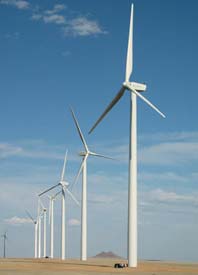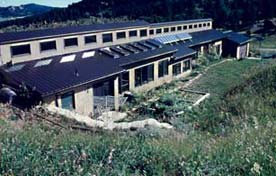Alternative Energy Sources Currently in Use
|
Photo courtesy DOE/NREL, Bill Timmerman photographer Rooftop PV modules on a village health center; Calcutta, India. |
Solar Power
The idea of harnessing the sun’s power has been around for ages. Only since the late 1970s has there been the technology to really make it happen. The basic process is simple. Solar collectors concentrate the sunlight that falls on them and convert it to energy. This is done in a number of ways, depending on whether the goal is electricity for a region or warm water for a pool. The biggest hurdle for solar energy is the price of installation. Solar equipment costs significantly more than traditional energy equipment. It takes many years of use to see that investment pay off. Despite the expense, solar power is a feasible way to supplement power in cities. In rural areas, where the cost of running power lines increases, solar power becomes the best choice for electricity.
Hydroelectric Power
Hydroelectric power uses the energy from falling water to turn turbines and generate electricity. Power generated this way relies on controlling flowing water—such as a river—often with a dam. Hydroelectric power has many advantages. It almost goes without saying that it is renewable. Water-powered generators do not produce emissions. Water flow—controlled within the hydroelectric plant—determines the amount of electricity produced, so power can be provided as needed. About 20% of the world’s electricity comes from this source. Leading users of hydroelectric power include Norway, Russia, China, Canada, the United States, and Brazil.
Biomass Fuel
|
Photo courtesy of DOE/NREL, Andrew Carlin, Tracy Operators photographers Truck unloading wood chips that will fuel the Tracy Biomass Plant, Tracy, California. |
“Biomass” describes almost any plant waste—wood waste, agricultural waste, landfill wastes—as well as certain crops used as a fuel. These wastes come from industries such as lumbering, building, or paper; agricultural wastes from farming; and even solid wastes from municipal landfills and the methane gas created in these landfills. In addition, certain grasses can be grown for fermentation into biofuels. Around the world, biomass fuel—mostly wood products—burns alongside coal in coal-fired electricity plants. Biofuels represent the other major use of biomass. Ethanol can be used alone or as an additive to gasoline. Brazil powers most of its vehicles with ethanol. Biodiesel—made from vegetable oil, animal fat, and restaurant grease—can fully replace standard diesel fuel. It also can be used in a blend. The biggest biodiesel producer and user is Germany.
Even though it burns and produces carbon dioxide, biomass fuel is considered to be “carbon neutral.” Fossil fuels release CO2 from eons ago, creating an extra load of CO2 in the atmosphere. The CO2 released when biomass fuels burn is taken up by the plants grown to replace them. However, fossil fuels are still used in the production of biomass fuel, powering the farming equipment, fueling the log trucks, and in other steps along the way. At this time biomass fuel is not truly carbon neutral. It does decrease overall CO2 emissions, though, which is a step in the right direction.
Wind Power
|
Photo courtesy of DOE/NREL, Sandia National Laboratories Colorado Green wind farm, near Lamar, Colorado |
Small windmills were common around the world until steam engines and, later, electricity replaced them. Interest in large wind turbines increased with the oil crises of the 1970s. By the 1980s wind farms—rows of turbines—began to dot countrysides all over the world. Leading users of wind energy include Germany, the United States, Denmark, and Spain, with India and China the up-and-coming users of wind power.
Giant wind turbines generate power when the wind turns the large blades. The blades attach to a generator, making electricity. Large wind farms can meet a utility’s basic power needs. Smaller wind farms and single windmills can power homes, telecommunications dishes, and water pumps. As with solar power, building a wind farm requires a large initial investment that does not necessarily pay off quickly.
Geothermal Energy
Geothermal energy takes natural features like hot springs and steam vents and uses them to produce electricity or supply a region with hot water. Geothermal power plants send the steam that reaches the Earth’s surface to turbines. The turbines turn, powering generators that make electricity. The first steam-based geothermal power plant opened in Larderello, Italy, in 1904. This plant remains in operation today. The United States, Iceland, the Philippines, El Salvador, Russia, Kenya, and Tibet are among the 24 countries that used the 8,900 megawatts of electricity generated by geothermal facilities in 2005. Direct geothermal heating utilizes hot water at the surface of the Earth—such as hot springs—to heat homes and other buildings. Over 16,000 megawatts of energy came from direct geothermal sources in 2005, in some 72 countries.
|
Photo courtesy of DOE/NREL, Joel Renner, NEEL, photographer The Steamboat Hills geothermal power plant in Steamboat Springs, Nevada. |
Nuclear Power
Nuclear power was pushed as an alternative to fossil fuels in the 1970s. Plants conducted nuclear fission in a controlled setting, producing power. Low fuel costs balanced the financial investment needed to build nuclear power plants, resulting in cheaper electricity. Despite the notable accidents at the Three Mile Island plant in Pennsylvania and at Chernobyl, Ukraine, nuclear power continues to be a viable source of power in many places. Nuclear power plants provide 16% of the world’s energy, in 70 countries. They are a vital source of power for countries without much natural fossil fuel resources. France and Japan have particularly active nuclear power programs. Plants now incorporate multiple safety systems to prevent core meltdowns and release of radioactive substances. Concerns remain about the disposal of spent fuel, which potentially could be used to make nuclear weapons.
Ocean Power
|
Photo courtesy of Dan Chiras, author, The New Ecological Home Passive solar house, Evergreen, Colorado. |
A tidal power plant captures the energy from the flow of the tide in and out of a bay or estuary. A special dam called a barrage separates the tidal area into upper and lower basins. Turbines within the barrage turn as the water flows from one basin to the other, depending on the direction of the tide. The turbines power a generator, which then makes electricity.
Installing a tidal plant is expensive, so the plant must be able to generate enough energy to make it worth the investment. That happens only when there is a difference of at least 5 m (16 ft) between high and low tide. Any less does not generate enough power to make a tidal plant financially feasible. Only about 40 sites around the world meet these criteria. The best-known tidal plant is La Rance Station in Brittany, France. Other sites include the Annapolis Royal plant, in Nova Scotia, Canada, as well as plants in Russia, China, India, and Wales.
Passive Heating and Cooling
One unique way to renewably heat or cool your house is through passive heating and cooling techniques. This approach combines energy from the sun with design and construction techniques to warm a building in the winter and cool it in the summer.
Passive EnergyIn the hot summer, a number of building techniques can help cool a house. A large overhang prevents the high rays of the sun from reaching the many south-facing windows. Leafy deciduous trees shade those windows as well. Open windows on the naturally shady north side help bring in cooler air. A ceiling fan draws air up towards the ceiling. The upper row of clerestory windows are opened, to let the hot air escape. In the cold winter, building techniques take advantage of the heat from the Sun and the ground. The deciduous trees have lost their leaves. Thermal windows in the south-facing front of the house permit the lower angled rays of the Sun to warm the interior of the house. These rays also pass under the overhang. The floor of the interior includes a thermal absorber, to retain heat. The ceiling fan pushes the rising warm air back down toward the floor.
Click for animation. |
Hydrogen Fuel Cells
Many people believe that the future is in hydrogen fuel cells—large ones for power plants, small ones for engines and other applications. The advantages of hydrogen are numerous. The hydrogen reaction produces heat, electricity, and water, but no pollution. Hydrogen is readily available and can be produced from fossil fuels or, more important, from renewable fuels. Hydrogen is cheap and more efficient than any technology involving turbines and significantly more efficient than internal combustion. However, right now hydrogen technology costs more than existing power sources. The actual setup of the systems—to control temperatures and to make fuel cells at usable sizes—is not yet known. These issues must be resolved before hydrogen fuel cells begin to replace other power sources.
Fusion
Nuclear fusion is an energy source still in the experimental stages. But what exactly is fusion? Fusion powers the sun and stars. Four hydrogen nuclei (protons) join together to produce a helium nucleus (two protons and two neutrons), along with some extra particles. A fusion reaction releases tremendous amounts of energy. The lethal hydrogen bomb uses fusion in an uncontrolled setting. Scientists have been working to control and harness the fusion reaction for energy production. In a controlled fusion reaction, the radioactive materials exist only for a relatively short time. The waste decays rapidly, with nothing that will stick around for a long time. In addition, the wastes cannot be used to make weapons. Fusion’s advantages are that it is clean and that the hydrogen needed to fuel the reactions is easy to get. The big problem with fusion is that to work, the reaction must be hotter than the interior of the sun. This heat needs to be confined to make fusion a useful energy provider.
The Distant Future
Researchers have long speculated on other types of renewable energy. One proposed method gets solar energy from special satellites in space, above the weather and the Earth’s rotation. Solar-powered satellites would collect the sun’s energy, convert it to electricity, and beam it back to Earth. This concept has been discussed for over 30 years, but costs and availability of other renewable energy sources have held back development. Another theory proposes getting large amounts of energy from the rotation of black holes.
This content has been re-published with permission from SEED. Copyright © 2025 Schlumberger Excellence in Education Development (SEED), Inc.







